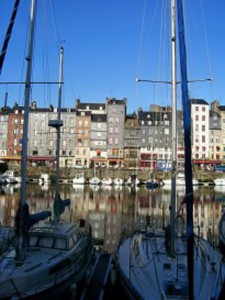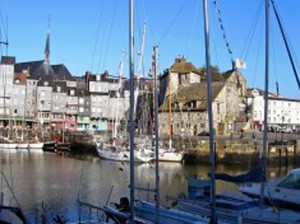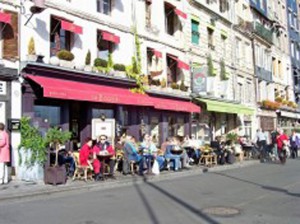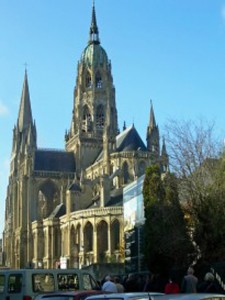FROM PARIS TO NORMANDY ON THE SEINE – HONFLEUR
FROM PARIS TO NORMANDY ON THE SEINE
This is the tenth and last in a series of articles about cruising on the Seine
THE PICTURESQUE CITY OF HONFLEUR
By Charles N. Stevens
Photos by Dolores Seidman
The sun greets us in all its glory this morning, a contrast to the rainy skies of yesterday. The air is fresh and the still wet streets glisten.
From the ship we walk toward the city, no more than a half mile away. Finally reaching the old part of town, we stop at a warehouse-like building formerly used to store salt. Its walls are constructed of white stone blocks that resemble large bricks of rock salt. Elaborate hand hewn beams support the high ceiling, giving us a clue to its age. This morning its vast interior space is devoted to a crafts and collectors fair, tables set up everywhere with everything imaginable for sale on them. One man sells the wires and logos attaching the corks to champagne bottles, another vendor offers old faded postcards.
A few moments later we make our way carefully down cobbled narrow streets, hoping not to turn an ankle, in what used to be the butchers area. Some of the older houses are half-timbered but others are constructed of flints imbedded in mortar. One 17th century building was formerly the city jail.
When we leave the narrow streets we come out upon a scene that is truly breathtaking, the small glassy harbor with docked sailboats along its edge and tall thin multicolored buildings of the city behind them. The narrow buildings, all flush with each other, are five to six stories tall, their gray roofs composed of slate shingles. On the ground floors shops and restaurants, many of them with outdoor tables, abound. As we walk by the restaurants the tantalizing aroma of gourmet dishes fills the air. Honfleur specializes in seafood. The four Cs of Normandy, however, are cider, cream, Camembert and cholesterol.
As it is the weekend, the streets begin to fill up with tourists as it is very popular with the French. British tourists also flock here along with them.
On one wall is the sculpted bust of Champlain, the founder of Quebec, Canada and whose name is attached to Lake Champlain in the United States. He was from Honfleur as well as the famous painter Boudin who was born here in 1824. Another painter, Jongkind, lived here in a half-timbered house until he died in 1891.
One of the most amazing buildings in Honfleur is St Catherine’s Church. Constructed by ship builders in 1453, it is entirely built of wood inside and out. The outer walls are covered with hundreds of small but thick wooden shingles but the base of the church is half-timbered. Its roof looks like an upside down ship, its interior columns also fashioned in wood. Wooden statues and carvings add their richness. Light streams in through diamond-paned windows, making the sanctuary warm and bright. A service is in progress as we quietly slip in the door. The organ resounds in the great wooden space, and a small white-robed choir along with the priest who is a marvelous tenor fills the church with the hauntingly beautiful sounds of their voices.
We continue our habit of window-shopping or as the French call it “window licking.” We peer through a window featuring flan, éclairs, and apricot and pistachio tarts then, another displaying nougats, macaroons of many colors and candied fruit. Almost next door is a window with Madeleines and bottles of cider and Calvados. An ice cream store displays its flavors in great swirls and decorates each with different kinds of fresh fruit. The appeal to the eye, the art of food is part of the French way of life. Among restaurants and wine shops are art galleries, many of them.
We walk by the restaurants again, looking at the outdoor tables that are beginning to fill up. Colorful awnings—maroon, gray, orange and green— shade part of the tables, and flowers decorate each one. Many women push baby strollers, others lead small dogs on leashes.
I stand at the edge of the small rectangular harbor admiring the sight of the docked sailboats and their reflections on the water. Errant breezes barely ripple the water and set the strings of small colored flags flapping on the boats. Gulls cruise slowly, drifting around aimlessly in the water. Others fly, crying over the masts of the boats. A woman sitting at the edge of the harbor gnaws on a long baguette sandwich while another pops French fries and small sausages into her mouth.
Later in the afternoon we are off to Bayeux, home of the famous Bayeux Tapestry. With the sun out in full force the fields and pastures look much greener today. The town has a long history, beginning with the Romans. The remains of Roman baths and temples have been found, but we see none of these. The Vikings too made their bloody mark on the town by burning it down. It is also prominent in the life of William the Conqueror and his victory at the Battle of Hastings in 1066 that resulted in the French taking over England.
Fortunately Bayeux was not damaged in World War II, the town being liberated only one day after D-day. Its hospitals were used to house American soldiers injured in the landings.
Soon after arriving we enter the museum where the tapestry is displayed. Actually it is not a tapestry in the sense of what we are used to, being more a long white cloth on which scenes have been crocheted. It is stretched out in a long curve in a dark room, dim lighting barely illuminating it. My first impressions are its great length, its remarkable state of preservation and the amount of knowledgeable labor that went into its production. It is 230 feet long, about 9 suburban front yards long. Attendants give us small listening devices that explain what is on the tapestry as it unfolds. We walk slowly along it, studying the crocheted figures and listening to the explanations. The tapestry depicts the story of William the Conqueror and the events leading up to the Battle of Hastings in 1066.
We briefly look at the monster Bayeux Cathedral, its spires sweeping up to the heavens. Its highest steeple holds a double dome that looks like a gigantic egg. The interior of the cathedral is much like all the others except that more transparent stained glass windows allow much more light to enter.
Tomorrow will sadly be our last day in France, a truly beautiful and fascinating country to visit.

Our first view of the harbor of Honfleur

Another view of this beautiful harbor

Gourmet cafes are all along the waterfront

Church at Bayeux, the city first liberated by American troops.



